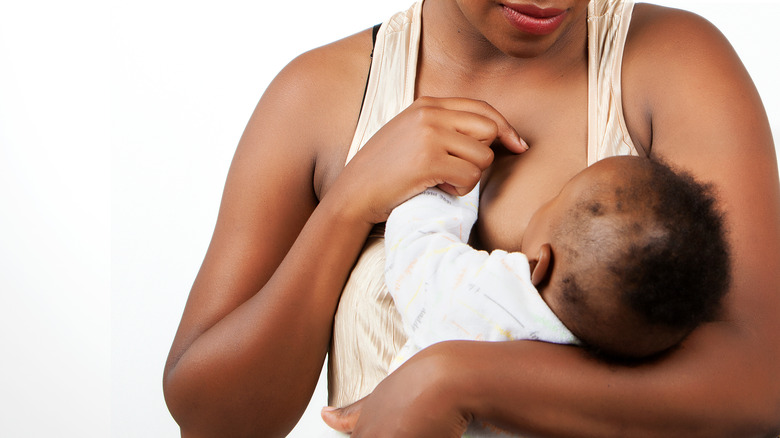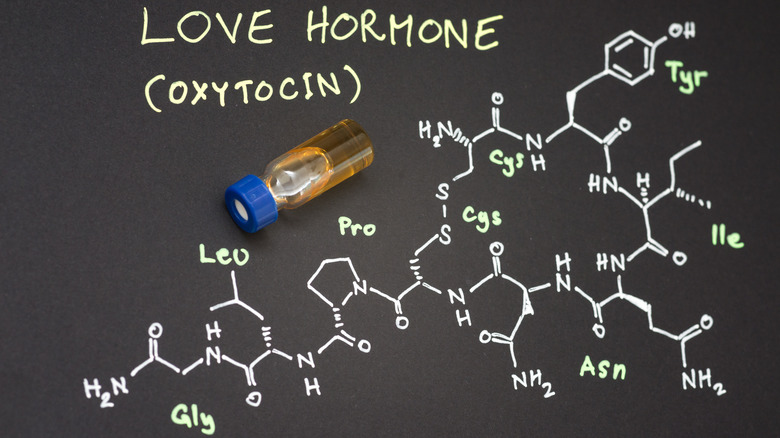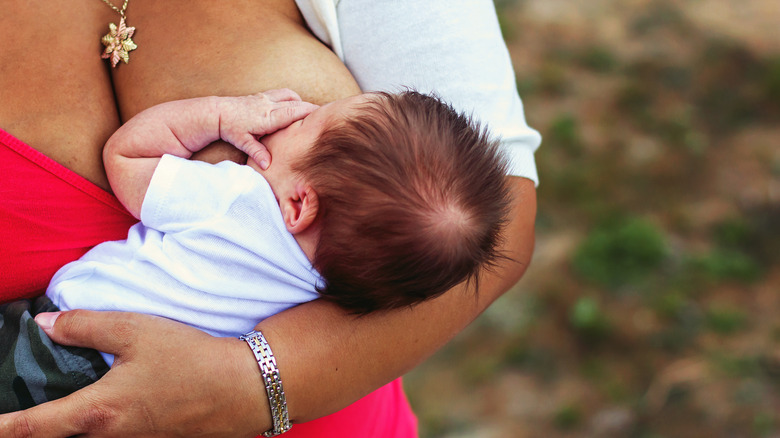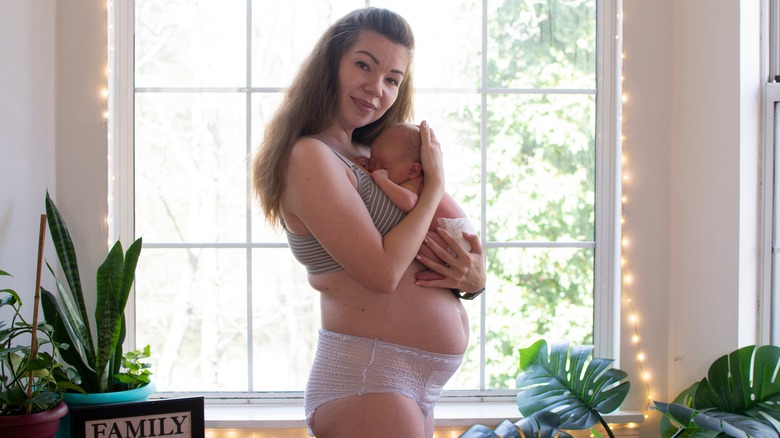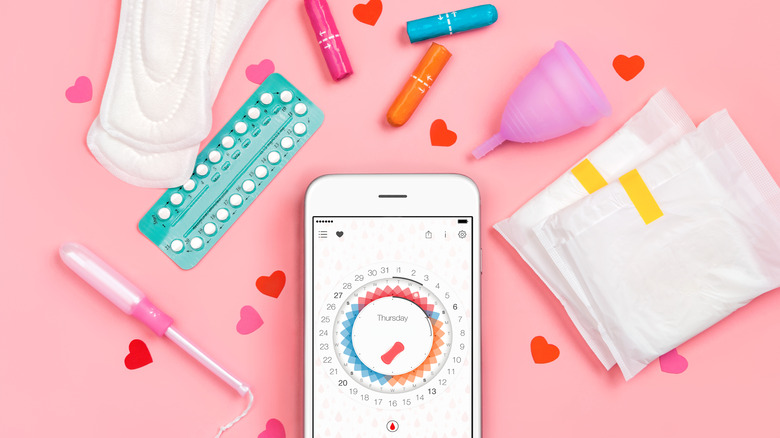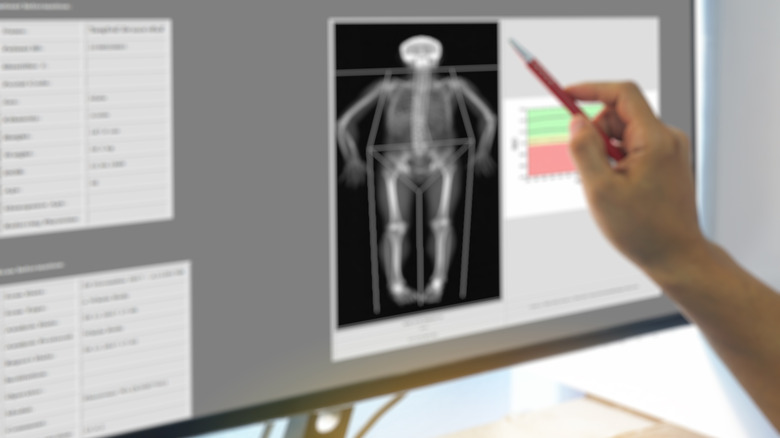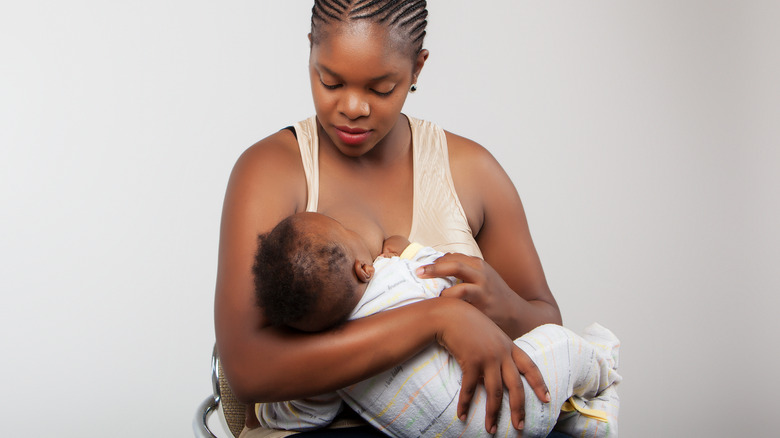What Happens To Your Body When You're Breastfeeding
Nursing, or breastfeeding, is the practice of a parent feeding their child breast milk, usually directly from their breast. According to the American Academy of Pediatrics (AAP), breastfeeding is highly beneficial for both the baby and their breastfeeding parent. Most importantly, breast milk contains the parent's natural immunity, which gets passed onto the child.
In babies, breastfeeding has been linked to reduced risk of respiratory infections, asthma, diabetes, gastroenteritis, inflammatory bowel disease, Celiac disease, Leukemia, and sudden infant death syndrome (SIDS). In parents, breastfeeding has been linked to reduced risk of postpartum bleeding, diabetes, rheumatoid arthritis, cardiovascular disease, breast cancer, and ovarian cancer. Breastfeeding also helps parents and babies bond.
Because of the myriad benefits for parents and babies alike, the AAP recommends that babies should be exclusively breastfed for the first six months of life. This means that the baby should only consume their parents' breast milk for the first six months, preferably directly from the breast. However, if a parent cannot feed directly from the breasts, breast milk can also be bottled so the baby can still reap many of the benefits. After six months, the AAP recommends introducing solid foods and supplementing with breastfeeding until the baby is one year old or older.
Breastfeeding can be a beautiful experience; however, it can also be really tough because your body changes a lot during this time. Here are some of the things that happen to your body when you breastfeed.
Your milk comes in
Your body starts preparing for breastfeeding before your baby is even born. Colostrum, the first milk your body produces, is actually present in the breasts as early as 12 weeks into your pregnancy, per Healthline. When your baby is born, the colostrum is in your breasts ready to get to your little one's mouth.
As the Women, Infants, and Children's (WIC) breastfeeding support program explained, breast milk production happens in clusters of cells within the breast tissue called alveoli. The milk then flows through the milk ducts to the nipple, where it flows out of small holes in your nipples. When your baby first suckles from the nipple, the sensation sends a signal to your brain, which causes the muscles around the alveoli to contract. This releases the colostrum in the alveoli into the milk ducts. As your baby continues to suck, the colostrum flows through the nipples so your baby can have its first meal.
Colostrum only lasts for the first day or two of breastfeeding. As your baby continues to breastfeed, your brain will send more blood to your breasts, which triggers more milk production. As you produce more milk, the composition changes to what's called transitional milk (via Healthline). For a few days, your body will continue to produce transitional milk as your body adjusts your breast milk to your baby's nutritional needs. Within a couple of weeks, you'll start producing mature milk, which is the milk your baby will drink until you wean.
Your body makes milk with the perfect nutritional profile for your baby
Breast milk is made up of water, fat, amino acids, carbohydrates, proteins, vitamins, and minerals. When the hormone prolactin is produced during pregnancy, it triggers your body to take proteins, sugars, and fats from your blood supply, which gets converted into milk. Breast milk also contains enzymes, white blood cells, antibodies, and other immune cells, which are essential to building your baby's immune system. So, by drinking breast milk, your baby gets all the nutrients, vitamins, minerals, and immunity they need to thrive.
Your breast milk also adjusts during every feeding and over time to meet your baby's needs. During each feeding, your baby gets both foremilk and hindmilk (via BabyCenter). Foremilk is high in lactose and water, which is important for hydration. Hindmilk is full of fat and protein, which is important for growth. Over time, the nutritional composition of your breast milk will change to meet your baby's nutritional needs as they grow. For the first six months of life, your baby can get everything they need from your breast milk.
As Baby's appetite and nutritional needs increase, solid food will help meet those demands, per the American Academy of Pediatrics (AAP). However, they won't be able to get all of the immune system components that they get from breast milk from solid food. So, it's still a good idea to give your baby breast milk, even as you add solids to their diet.
Your body produces lots of oxytocin
You might be familiar with oxytocin as the "love hormone." According to Verywell Family, it's also commonly called the "mothering hormone" because it plays such an important role in fostering the bond between parent and baby and breastfeeding.
Oxytocin is the primary hormone responsible for getting breast milk from your breast to your baby. When your baby breastfeeds, the brain releases lots of oxytocin. That hormone dump triggers the muscles in the breast to contract, which pushes the milk from the alveoli to the milk ducts. Then the milk ducts contract to push the milk to your nipple and out to your baby's mouth. The first big flow of milk precipitated by oxytocin production is called the let down reflex. As your baby continues to suck, your brain continues to produce large amounts of oxytocin to get the milk flowing steadily.
Oxytocin is also the hormone responsible for creating feelings of love. When your brain produces it in large quantities, like when you're breastfeeding, you'll often get a strong feeling of love for and connection with your baby. This helps you bond with your baby and creates a strong desire to care for your baby. Cuddling your baby and holding them skin-to-skin is another great way to get a boost of oxytocin. People who have trouble breastfeeding are often encouraged to cuddle their babies for a bit before breastfeeding, especially skin to skin, to get the oxytocin flowing and encourage the let-down reflex.
Your breasts get larger
During pregnancy, your breasts go through a lot of changes – the most noticeable of which is an increase in cup size, per Medical News Today. That growth doesn't stop once you give birth. Your breasts will increase in size again when your milk first comes in, and they will likely stay larger for the first few months during breastfeeding. Some people find that their breasts stay larger for the entire time they're breastfeeding.
Your breasts may also go through slight size changes throughout the day. Between feedings, your breasts will slowly increase in size as they fill with milk. They may even become hard if they get too full. Feeding your baby will make your breasts a little bit smaller and they'll probably feel softer because they aren't full of milk.
According to What to Expect, your breasts will likely get a bit smaller once your baby starts eating solids, usually around six months old. Since your baby will be consuming less breast milk, your breasts will adjust milk production accordingly, leading to smaller breasts. Some people find that their breasts return to their pre-pregnancy size once they stop breastfeeding. However, many people find that their breasts don't look the same. When your breasts grow during pregnancy and breastfeeding, the muscles and ligaments in the breasts stretch. The muscles and ligaments don't get tighter, even when the breasts shrink. Unfortunately, this can lead to saggy breasts post-breastfeeding.
Your breasts will likely become engorged and leak
After your milk first comes in, your breasts will start to produce a ton of milk to ensure there's enough to nourish your baby, per Michigan Medicine. Milk production typically peaks between three and five days after your baby is born. This uptick can lead to breast engorgement, which happens when your breasts are overfull.
Some people just feel like their breasts are very full and heavy. For others, engorgement can be incredibly uncomfortable. Your breasts might feel tender or start to throb. Sometimes they can get rock hard and feel warm to the touch. The skin might stretch to the point where it's tight and shiny. If the breasts become too engorged, they will start to leak milk. The best way to relieve engorgement is to breastfeed your baby, which empties the breasts. During the feeding, let your baby nurse for as long as possible after the let down reflex so your breasts empty as much as possible. If your baby just ate and you're still engorged, you can put warm compresses on your breasts or take a hot shower to relieve the discomfort.
With regular breastfeeding, your body will figure out how much breast milk your baby needs and adjust milk production accordingly because the production is dictated by supply and demand. Once your body figures out the right amount of milk to make for your baby, engorgement will be less likely as long as you feed your baby at regular intervals (via What To Expect).
You might get clogged ducts or mastitis
One of the reasons that it's very important to empty each breast as much as possible during each feeding is that not doing so can lead to clogged milk ducts or even mastitis. According to the Mayo Clinic, clogged ducts happen when the flow of breast milk is obstructed within one of the milk ducts or in the nipple. If a clogged duct persists for too long, an infection called mastitis can develop.
The first sign that you might have a clogged duct is pain in your nipple or your breast. Then you may notice a hard, painful lump in your breast. Eventually, the skin around the lump will become warm, indicating that there's inflammation in the area. If you suddenly develop a fever, chills, and body aches, then you probably have mastitis. The pain will become intense and you may notice red streaks on your breast around the clogged duct. If you develop symptoms of mastitis, it's important to see your doctor ASAP. You may need antibiotics to treat the infection.
Clogged ducts can usually be treated by feeding your baby as often and as long as possible, per Medical News Today. Point your baby's nose or chin toward the clogged duct to encourage milk to flow from that location. Applying a warm compress to your breast for 20 minutes before feeding or soaking in a warm bath with Epsom salts may help the duct to unclog during the next feeding.
Your nipples might hurt
According to the American Pregnancy Association, 90% of new parents that choose to breastfeed experience nipple pain, especially for the first few days. The most common causes of sore nipples are your baby not getting a good latch on your nipple, not breaking the suction between your baby's mouth and your nipple before taking them off your breast, and the position of your body while you breastfeed. Wearing tight bras or tight clothing can also contribute to nipple soreness so make sure you're putting on your comfiest, loose-fitting clothes for the first few weeks.
According to Nemours, some nipple pain when you first start breastfeeding is normal. But if your pain persists or your nipples start to crack, blister, or bleed, seek the help of a lactation consultant. If breastfeeding is so painful that you dread doing it or your nipples hurt between feedings, that's not normal.
The best ways to prevent sore nipples are to ensure that your baby has a proper latch when they start a feeding, and to break the seal between your baby's mouth and your nipple when the feeding is done. Learning how to do these things can be frustrating and difficult for new parents, and that's okay. Make sure to ask lots of questions while you're still in the hospital and set up an appointment with a lactation consultant if you're having any trouble.
You might have some neck, shoulder, and back pain
Neck, shoulder, and back pain are all common complaints from parents embarking on their breastfeeding journey. According to Healthline, poor posture is behind most of these aches and pains. Many new parents make the common mistakes of hunching over so their baby can reach their breast, looking down at their baby the entire time they're breastfeeding, not properly supporting their back, and holding their babies in an uncomfortable position.
Luckily, there are some easy fixes that can help relieve neck, shoulder, and back pain from improper breastfeeding posture. First, sit in a supportive seat with your back pressed against the backrest. Plant both feet on the floor and keep your back straight but relaxed. Place your baby on a pillow to bring them up to your breast so you don't have to lean forward. If their head still doesn't reach your breast, you can place a rolled-up blanket or towel under their head. Arrange the pillow and towel so you don't have to hold your baby up to your breast. Then bring your baby up to your breast instead of hunching over to reach your baby.
Though it's important to connect with your baby during breastfeeding by making eye contact, smiling, and talking, it's also important that you don't look down the entire time. Take breaks from looking at your baby by letting your head rest back or resume a neutral position.
Your body burns more calories
Making breast milk is a lot of work for your body. While you're breastfeeding, your body will passively burn more calories, according to Healthline. Each body is different, so the exact amount of extra calories burned from breastfeeding varies. On average, people who breastfeed burn about 500 more calories a day than people who don't breastfeed.
Getting enough calories into your body is incredibly important for you and your baby. You need to eat enough to produce nutritious breast milk and nourish your own body as well. You'll need to increase your caloric intake a bit while breastfeeding. According to Parents, the exact amount of extra calories you'll need to consume depends on your body size, your typical caloric intake, how much breast milk your baby is consuming, and how active you are postpartum.
Dr. Kecia Gaither, an OB-GYN and expert in fetal medicine, told Parents that breastfeeding parents should consume "at least 1500-1800 calories per day — perhaps more" depending on activity level. Registered dietitian Robyn Price told Parents that the body also needs more calories to recover from childbirth. People who've endured difficult childbirth or a cesarean section may need more calories to support their healing than someone who had a relatively "easy" birth.
Focusing on how many calories you need while breastfeeding can be just another stress for new parents. The most important thing is to ensure you carve out time to eat nutritious meals.
You might be hungry all the time
Since your body is torching a ton of calories to make breast milk, you might find that you're hungry all the time. According to Parents, lack of sleep can also factor into your massive appetite. Lactation consultant Diana West told the site that the unavoidable lack of sleep that happens with a newborn disrupts the production of insulin and a hormone called prolactin. The imbalances in these hormones activate your hunger cues, and specifically make you crave carbohydrates. So, if you're polishing off an entire box of crackers or emptying the breadbox, there's a really good reason!
West also said that these cravings are "actually nature's built-in way of ensuring that nursing mothers get enough energy to cope with the reduced amount of sleep." Don't feel bad if you're snacking all the time — your body is telling you it needs more fuel.
According to Healthline, it's important to choose foods that will actually give you energy and help your baby get all the nutrients they need. Nutrient-dense, filling meals and snacks are the best way to beat the hunger monster and keep going no matter how tired you are. Aim to eat foods with a lot of protein and healthy fats like fish, eggs, avocados, chicken, and beef. Nuts and seeds are satisfying snacks, and if you can tolerate dairy, milk, yogurt, and cheese are great ways to fill up and get the vitamins and minerals you and your baby need.
Breastfeeding helps your uterus return to its normal size
When you're pregnant, your uterus drastically increases in size to accommodate your growing baby. According to Mass General Hospital, it takes about six weeks for your uterus to return to its pre-pregnancy size. Uterine contractions are an important part of the shrinkage process. These contractions start as soon as you give birth and continue over the next few days. The contractions cause cramps that feel like period cramps for a few days, or sometimes a few weeks, after giving birth. These cramps can be quite uncomfortable, but they're completely normal and crucial. Uterine contractions postpartum help prevent blood clots and heavy bleeding.
Oxytocin, the "love hormone" that's released in massive quantities when you breastfeed, causes uterine contractions. So one of the best ways to get your uterus back to its normal size postpartum and prevent bleeding problems is to breastfeed as frequently as possible.
Ibuprofen can help reduce you manage the pain. Deep breathing techniques like the ones you used during labor may help as well. Though you probably won't feel like getting up and active, going for an easy walk can also help relieve the cramping (via Mass General).
Your period might not come back until you stop breastfeeding
Prolactin, the primary hormone involved in lactation, also plays a major role in your menstrual cycle. Since prolactin is produced in large quantities to fuel milk production, you might not get your period while you're breastfeeding, according to WebMD.
Though many people don't get a regular period until they start weaning their baby, breastfeeding is not a guarantee that you won't get your period. Each body is different, so each body responds to prolactin in a different way. Some people will get their periods back within six weeks of giving birth and continue to have regular periods regardless of whether they're breastfeeding. Other people will have light, irregular periods or spotting while breastfeeding and their regular period will return when they stop breastfeeding. Still others will have no bleeding at all until they stop breastfeeding.
Reducing the amount of breastfeeding can also be a trigger for restarting the menstrual cycle. Many people find that their period comes back when their baby stops needing an overnight feeding or when their baby starts solids. There's no definitive way to know whether you'll get your period while breastfeeding or not. If your period does stop while breastfeeding, that doesn't mean that you can't get pregnant again. Some people don't ovulate while breastfeeding, while others do. Be sure to use backup birth control to avoid unintended pregnancy.
Your bone density changes
One of the primary minerals your baby needs to thrive and grow is calcium, according to the National Institutes of Health (NIH). Your baby will receive necessary calcium directly from you during breastfeeding. In fact, while you're breastfeeding, your body actually diverts calcium from your bones to breast milk production. Your body will also produce less estrogen, which is an essential hormone for protecting the bones.
Studies have found that women lose between 3% and 5% of their bone density while they're breastfeeding (via NIH). Luckily, the loss isn't permanent. Research has shown that bone density usually returns to normal within a few months after breastfeeding stops.
According to the NIH, there are a few ways that you can protect your bones while breastfeeding. The first and most important is to consume plenty of calcium-rich foods. These include dairy products like milk, cheese, and yogurt, as well as dark, leafy greens and fatty fish like sardines and salmon. You might also need a multivitamin that's high in calcium. Exercise also helps strengthen the bones and muscles. As such, it's important to exercise while breastfeeding. Simple exercises like walking, bodyweight strength training, and lifting light weights are safe and beneficial during breastfeeding.
Is breast really best?
Many new parents constantly hear the phrase "breast is best" from family members, friends, doctors, and even strangers. MedlinePlus, the National Institutes of Health's medical library, stresses that "health experts agree that breastfeeding is the healthiest option for both mom and baby." The American Academy of Pediatrics (AAP) also asserts that breastfeeding "should be considered a public health issue and not only a lifestyle choice."
There are good reasons why breastfeeding is so adamantly recommended. There are myriad health benefits for parents and babies. Breastfeeding helps deepen the bond between a new parent and their baby. Breast milk is perfectly formulated to meet all a baby's nutritional needs, and it is cheaper than formula feeding.
However, the forceful recommendation to breastfeed can leave many new parents feeling immense pressure to breastfeed, even if it isn't working out, according to Slate. Though MedlinePlus and the AAP both insist that there are relatively few medical reasons why a person might find themselves unable to breastfeed, research cited by Slate has found that one in five new parents don't produce enough milk to sufficiently feed their babies within the first few days. Some research has shown that 10 to 25% of exclusively breastfed newborns lose weight rather than gain weight, and up to 18% experience starvation jaundice from insufficient milk.
While breastfeeding can be incredibly beneficial to parents and babies, it may not be the right choice for you and your baby — and that's okay.


